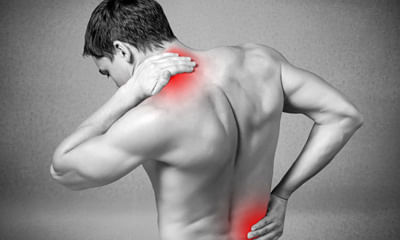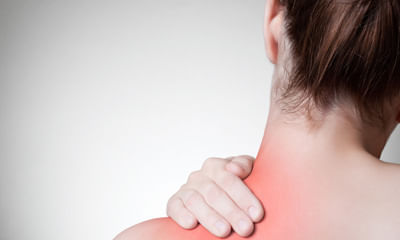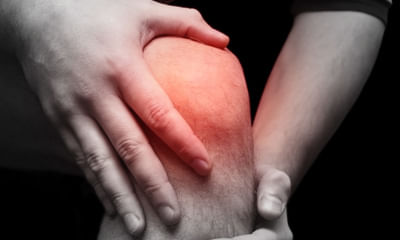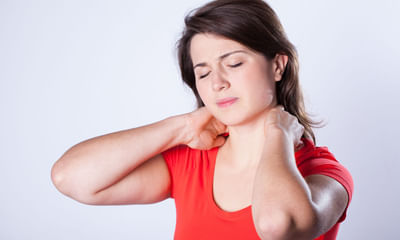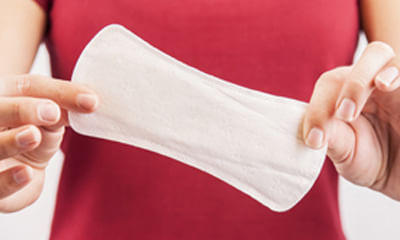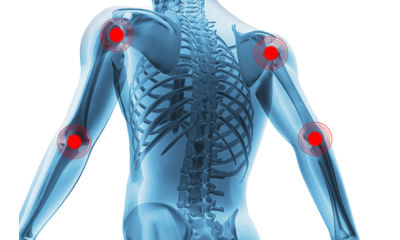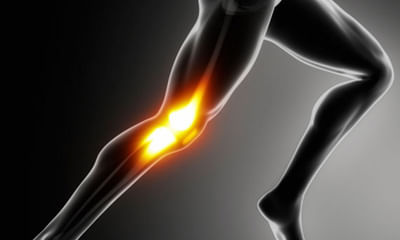Medicine For Joint Pain
Hi, last monday I had a sex with new type condoms. Its like forced to insert mine and landed normally. Next day I notice ...
Ask Free Question
Hello- signs are suggestive of sexually transmitted infection, most probably herpes. Its best to get it tested first before going into any kind of treatment or else it might affect your whole reproductive system badly.
My mother aged 84 y.for shoulder pain can she take myotp p with other medicines concurrently viz amlodipine 5 mg, shelca ...
Ask Free Question
Shoulder pain - left and also chest pain and also back pain. If you have left hand shoulder back pain and also chest pain it might be due to shoulder pain which itself is called peri arthritis shoulder perhaps if you have movement restriction in the shoulder joint especially in the left side it could be also due to diabetes mellitus or due to pa shoulder. This can be ruled out with my above suggestions. But if you don't have any above mentioned issues or symptoms, then we need to rule out the gastric trouble which you might be the reason for you to have shoulder back pain as well as chest pain. If it is due to gastritis the you can avoid tamarind in the food and also you can avoid smoking if you are a smoker. You can drink hot water to feel better along with regular aerobic activities and breathing exercises involving deep breathing exercises involving both the shoulder and abdomen - diaphragmatic breathing exercises which will help you to come out of this issue. Hope you find better and let us know.
Am just 27 year old female. I have right side sciatica and si joint inflammation for the past two years. Now I am feelin ...
Ask Free Question
SI joint inflammation will take some time to get reduced. Take medicines accordingly as suggested by the doctor, consult with physiotherapist and take electrotherapy for 2 weeks. Through ift+us therapy and exercises will help reduce the pain.
Im a footballer who got a meniscus tear and got recovered has pain when I bends my right knee but without having the bod ...
Ask Free Question
You may still be experiencing some residual issues related to your meniscus tear, even though you have recovered from the initial injury. The specific symptoms you described, such as pain when bending the knee while sitting and needing to tighten your calf to feel the pain, suggest that there may be ongoing irritation or inflammation in the knee joint. One possibility is that you could be experiencing a condition called "meniscal irritation" or "meniscal impingement. This occurs when the torn edge of the meniscus rubs against other structures in the knee joint, causing pain and discomfort, particularly during activities that involve bending the knee. Another possibility is that you may have developed some scar tissue or adhesions in the knee joint as a result of the initial injury and subsequent healing process. This scar tissue can sometimes cause stiffness and discomfort, especially with certain movements like bending the knee while sitting. It's important to have your knee evaluated by a healthcare professional, preferably one specializing in sports medicine or orthopedics. They can perform a thorough examination, possibly including imaging studies like an mri, to determine the exact cause of your symptoms and recommend an appropriate treatment plan. This may include physical therapy to improve flexibility and strength, specific exercises to address any imbalances or weaknesses, and possibly further interventions such as injections or, in some cases, surgery to address any ongoing issues with the meniscus or other structures in the knee joint.
Hello sir, my mother age 58 years no diabetes, no chronic diseases. Present since she is suffering with both knee pains, ...
Ask Free Question
Ice therapy would definitely help to reduce the inflammation. We also advise you to use knee cap which would help to prevent the knee from damaging further and also to maintain the quadriceps muscle tone. Stiffness might have developed due to weakness of the ligaments &inflammed cartilage. Specific knee exercises will also help ie. Keeping ball underneath the knee and keep pressing it. That's the simple exercise which will help you to strengthen the knee. You need to consume good protein and iron diet in your body which will help you to break the fatigue and general body pain. However non veg foods definitely makes you to get increased with the toxin levels in the body and it makes your knee to have less fluid content in the system. In general we suggest patients who has knee pain to eat more water content vegetables which will definitely help you to feel better. This is a general knee pain and for this you can follow these measures: one keep a pillow right under the knee while sleeping, next is you can keep ice in the painful area for about 5--10 minutes, it looks like you are is important to check that. Anaemia always leads to the symptoms of being tired and also having body pain though there may not be any pathological reasons for knee pain. With knee exercises you will definitely feel better and muscles must be strengthened. •patellar tendinitis: •risk factor •a combination of factors may contribute to the development of patellar tendinitis, including: •physical activity. •running and jumping are most commonly associated with patellar tendinitis. Sudden increases in how hard or how often you engage in the activity also add stress to the tendon, as can changing your running shoes. •tight leg muscles. Tight thigh muscles (quadriceps) and hamstrings, which run up the back of your thighs, can increase strain on your patellar tendon. ••muscular imbalance. •if some muscles in your legs are much stronger than others, the stronger muscles could pull harder on your patellar tendon. This uneven pull could cause tendinitis. •chronic illness. •some illnesses disrupt blood flow to the knee, which weakens the tendon. Examples include kidney failure, autoimmune diseases such as lupus or rheumatoid arthritis and metabolic diseases such as diabetes. •complications •if you try to work through your pain, ignoring your body's warning signs, you could cause increasingly larger tears in the patellar tendon. Knee pain and reduced function can persist if you don't tend to the problem, and you may progress to the more serious patellar tendinopathy. •prevention •to reduce your risk of developing patellar tendinitis, take these steps: •don't play through pain. As soon as you notice exercise-related knee pain, ice the area and rest. Until your knee is pain-free, avoid activities that put stress on your patellar tendon. •strengthen your muscles. Strong thigh muscles are better able to handle the stresses that can cause patellar tendinitis. Eccentric exercises, which involve lowering your leg very slowly after extending your knee, are particularly helpful. •improve your technique. To be sure you're using your body correctly, consider taking lessons or getting professional instructions when starting a new sport or using exercise equipment. •therapy •a variety of physical therapy techniques can help reduce the symptoms associated with patellar tendinitis, including: •patellar tendon strap. A strap that applies pressure to your patellar tendon can help to distribute force away from the tendon and direct it through the strap instead. This may help relieve pain. •iontophoresis. This therapy involves spreading a corticosteroid medicine on your skin and then using a device that delivers a low electrical charge to push the medication through your skin. •platelet-rich plasma injection. This type of injection has been tried in some people with chronic patellar tendon problems. Studies are ongoing. It is hoped the injections might promote new tissue formation and help heal tendon damage. •probably your stamina would've gone down due to over use of the joints and the metabolic activity is more due to running. You need to consume good protein diet so that your body will act as a reservoir. It will help you to fight against rather than affecting one particular area of your body for eg. Knee joint. For knee ligament pain or inflammation you need to keep ice which will help you to prevent the inflammation progressing further. •patellofemoral pain syndrome •usually fully relieved with simple measures or physical therapy. It may recur, however, if you do not make adjustments to your training routine or activity level. It is essential to maintain appropriate conditioning of the muscles around the knee, particularly the quadriceps and the hamstrings. •there are additional steps that you can take to prevent recurrence of patellofemoral •they include: •wearing shoes appropriate to your activities •warming up thoroughly before physical activity •incorporating stretching and flexibility exercises for the quadriceps and hamstrings into your warm-up routine, and stretching after physical activity •increasing training gradually •reducing any activity that has hurt your knees in the past •maintaining a healthy body weight to avoid overstressing your knees ••d cartilageacl •joints, ie. In the upper limbs if the pain is present in the fingers/wrist and in the lower limbs it the pain is present in the toes/ ankle, then we shall definitely say it is rheumatic arthritis. •if your proximal joints (ie. Shoulder, hip & knee has pain) then you can pour hot (warm) water in that area to reduce the inflammation. If you have pain in the distal joints ie. Wrist, fingers, ankle, toes then you can wear either elbow brace or wrist brace which will help you to feel warm and very protective. And also immerse the distal joints in the hot water tub which will help you to reduce the pain. ••knee pain during driving or watching movie. •it might due to lack of movements in the knee while the joints are immobilized during driving and while watching movies. It is important that you need to have movements in and around the knee so that the blood flow will not be disturbed. •knee ligament laxity•if you have problem in your legs then it might be due to ligament laxity where your legs would become very weak due to the old ligament injury and that should be treated immediately. •wear knee cap so that you will feel firm while walking or climbing stairs.•this is a general strain and for this you can follow these measures: one keep a pillow right under the knee while sleeping, next is you can keep ice in the painful area for about 5--10 minutes, if pain still persists you can stretch your body by twisting the waist on both sides how we used to do in the school drill similarly you can try! one time you can do hot water fermentation that would help to reduce the muscle strain.•legs becoming numb and also pain is there when the patient walks for 10-15 minutes?•it looks like you are anaemic. If you feel that the legs are becoming numb then keep your legs warm which is important, probably you can wear mcr chappals inside the house/ socks inside the house. Put a door mat when ever you sit so that you will feel comfortable. Also pour warm water in the legs which would help you to get better circulation. •knee pain. If you are overweight, losing weight will also help to reduce pressure on your knee. •knee pain, when leg folding time get pain. The importance of buying braces and splints from us – orthopaedic support braces we suggest you to wear knee brace which is available at our clinic. If you want you can buy from us, if you are far away from chennai we can send you by courier. The reason why we are conveying you to buy from us is we can demonstrate over the videocall (using whatsapp) and also we can monitor you throughout when to wear it and how long to wear it. And also if you find any difficulty wearing the brace you can also revert back to us for few more suggestions and we can propose you good solution how to go about it. Resisted terminal knee extension: make a loop with a piece of elastic tubing by tying a knot in both ends. Close the knot in a door at knee height. Step into the loop with your injured leg so the tubing is around the back of your knee. Lift the other foot off the ground and hold onto a chair for balance, if needed. Bend the knee with tubing about 45 degrees. Slowly straighten your leg, keeping your thigh muscle tight as you do this. Repeat 15 times. Do 2 sets of 15. If you need an easier way to do this, stand on both legs for better support while you do the exercise. Standing calf stretch: stand facing a wall with your hands on the wall at about eye level. Keep as arthritis is very common that you get generally bilaterally. Ice therapy would definitely help to reduce the inflammation. We also advise you to use knee cap which would help to prevent the knee from damaging further and also to maintain the quadriceps muscle tone 1. Heel and calf stretch 2. Quadriceps stretch to do this stretch: 1. Stand next to a wall or use a chair for support. Your feet should be shoulder-width apart. 2. Bend one knee so your foot goes up toward your glutes. 3. Grab your ankle and gently pull it toward your glutes as far as you can comfortably. 4. Hold for 30 seconds. 5. Return to the starting position and change legs. 6. Repeat 2 times on each side. You need to consume good protein and iron diet in your body which will help you to break the fatigue and body pain. You have to reduce the weight by walking minimum 1 km per day. Slowly reduce the weight and slowly avoid adding salt in the diet which will help you to prevent water retention in the body. Excess salt in general leads to water in the body which might be the reason for you to have leg pain. Hotwater fermentation that would help you to get relieved from joint pains. But food precautions, it is better to avoid tamarind in the food rather to add lime or mango. You can generally do basic aerobic exercises which will definitely help to improve the body weakness. Consume good protein and vitamin diet which will help you to improve your weakness of the whole body. You can give good vitamin d and calcium which will help to have quick healing. If you are a non veg person consume seer fish or if you are a veg person eat mushrooms which has vitamin d3. You need to consume water content vegetables which will make you feel hydrated. A good brace will protect your knee and take the pressure off your meniscus, allowing it to rest. Your doctor may recommend the rice regimen—rest, ice, compression, and elevation—to treat a eroded cartilage which is the main reason for the synovial fluid to get drained. Resting your knee can help relieve your symptoms. Steps to heal a worn out cartilage naturally: rest: it's crucial to rest your knee after it starts to ache. You should not participate in activities where you could cause additional strain. Ice: apply ice to your knee for 15 minutes at four-hour intervals.
I am anemic, I have bone pain, I am underweight, I am having severe muscle spasm and harding if I sit for long period in ...
Ask Free Question
Homeopathy has very effective and reliable treatment for your problem. No side effects. Please take homeopathic medicine, preliminary dose, rhus tox 200-once daily in the evening for 3 days. Book online appointment/consultation with me -(commencing from text consult rs 149, audio/ phone-rs 300) for further more comprehensive prescription and treatment.
While walking and bending my knee makes sound. My weight is 109 kg. Please suggest medicine as I am unable to do exercis ...
Ask Free Question
Often, crepitus is harmless. It happens when air seeps into the soft tissues around the joint (such as the kneecap). When you bend the joint, the air bubbles burst, and you hear a bone cracking sound. While most crepitus is harmless, some forms of crepitus signal a problem.
She is having severe periods pain for a long time. During her periods she also have fever, joints pain and sometimes she ...
Ask Free Question
Hi, Lybrate user, •its dysmenorrhoea ,she is suffering from experiencing cramp abdomen, joint pain with indigestion causing nausea and vomiting. •she should take, plenty of water to hydrate her ,eliminating toxins ,nourishing her body ,establishing her normal flow. • go for meditation to reduce her stress, anxiety to calm her nerve ,easing her stress in order to improve haemoglobin level. • her diet be simple, non- irritant, easily digestible on time to maintain her digestion, avoiding gastric disorder, minimising cramp abdomen •tk, apple,carrots, cheese,milk, banana,papaya, pomegranate, spinach,almonds, walnuts to feel energetic, improving haemoglobin level. •consult ,privetly for a faster recovery, till, then take, homoeopathic medicine, underlying: @ pulsatilla 30ch-5 drops ,thrice, orally, daily. •ensure, sound sleep in the night for at least 7 hrs.• avoid, caffiene,junk food, dust,smoke, exertion tk, care,
Hi, hip and sacroiliac joints pain comes under which department? Neuro surgeon or orthopedic. ...
Ask Free Question
Orthopaedic. Sacroiliitis (say-kroe-il-e-i-tis) is an inflammation of one or both of your sacroiliac joints — situated where your lower spine and pelvis connect. Sacroiliitis can cause pain in your buttocks or lower back, and can extend down one or both legs.
My mother is 56 years old. She has been suffering with knee joints pain from last 9 years. Doctor says for knee replacem ...
Ask Free Question
Diabetes and knee replacement: diabetes can increase the risk of complications during surgery, including knee replacement surgery. However, many people with well-controlled diabetes can undergo knee replacement surgery safely. It's essential for your mother to discuss her diabetes management with her healthcare provider and the orthopedic surgeon who will perform the knee replacement. They will assess her overall health and determine if she is a suitable candidate for surgery. Close monitoring of blood sugar levels before and after surgery will be important to minimize the risk of complications. Numbness in feet: numbness and tingling in the feet can be symptoms of diabetic neuropathy, a common complication of diabetes that affects the nerves. It's important for your mother to have a thorough evaluation by a healthcare provider to assess her symptoms and determine the underlying cause. Additional tests, such as nerve conduction studies or electromyography (emg), may be recommended to evaluate nerve function. Shoulder, arms, and legs pain: pain in the shoulders, arms, and legs can have various causes, including arthritis, nerve compression, muscle strain, or other musculoskeletal conditions. Your mother may benefit from a comprehensive evaluation by a healthcare provider, possibly including imaging studies such as x-rays or mri, to determine the cause of her pain and develop an appropriate treatment plan. Comprehensive check-up: to address your mother's multiple symptoms and concerns, it's important for her to undergo a comprehensive medical evaluation. This may include: blood tests: to assess blood sugar levels, kidney function, lipid levels, and other metabolic parameters. Nerve function tests: to evaluate for diabetic neuropathy or other nerve-related issues. Imaging studies: such as x-rays, mri, or ultrasound to assess the condition of the knee joints, shoulders, and other affected areas. Consultations with specialists: such as an orthopedic surgeon, endocrinologist (for diabetes management), or neurologist (for nerve-related issues). Holistic approach: given your mother's multiple symptoms and medical conditions, a holistic approach to her care may be beneficial. This could include optimizing diabetes management, incorporating physical therapy or exercise programs to improve mobility and strength, and exploring options for pain management and symptom relief.


